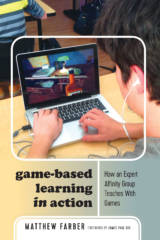Adapted from Game-Based Learning in Action: How an Expert Affinity Group Teaches with Games by Matthew Farber published by Peter Lang.
Professor Karen Schrier, Founding Director of the Games & Emerging Media program at Marist College, developed the Ethics, Practice, and Implementation Categorization (EPIC) Framework in 2015 for the use of use video games in ethics education, proposing seven educational goals, and 12 strategies for ethics games. For example, the video game Journey can help students to convey emotion and perspective, while iCivics’ Argument Wars teaches the deliberation of real world issues.
Games offer more to players than goals of winning. The experiences along the way may often present ethical challenges to players. The idea of the EPIC Framework is to be a tool for teachers to refer to when considering which games to use in classrooms. The goals and strategies were drawn from a literature review of vetted frameworks. Schrier told me:
I thought about the different types of goals a teacher might have in trying to teach ethics. Goals might be building ethical awareness, enhancing character, or helping students practice reflection. I also looked at 12 different strategies that might be used in ethics education, things like role-play or modeling of behavior, simulating scenarios or issues. I used it to help teachers understand the appropriate game to meet their own goals and strategies.
 Educational goals also include enhancing emotional intelligence, practicing self-care, and cultivating facility with major ethics issues, approaches, and frameworks. The 12 strategies game designers use to deepen a player’s understanding of ethics are:
Educational goals also include enhancing emotional intelligence, practicing self-care, and cultivating facility with major ethics issues, approaches, and frameworks. The 12 strategies game designers use to deepen a player’s understanding of ethics are:
- Emotion, mood, and tone
- Diaries or personal reflection devices
- Role-taking and role-playing
- Story or narrative
- Modeling through avatar or character
- Choices and consequences
- Simulation
- Social interaction and collaboration
- Deliberation, dialogue, and discourse
- Applications to real-world issues
- Procedural exploration and interaction
- ‘Nudges’ or contextual and/or personalized clues
When considering a game to teach ethics, Schrier said one must consider what might be the best match for the teacher’s classroom. “The context and goals of the classroom need to be at the forefront,” said Schrier. You can’t just drop in [the US History game series] Mission US, or [the immigration game] The Migrant Trail without thinking through the kinds of strategies and goals you want to meet.” Educators must also play the game in advance and “think about the maturity of the students and the goals they have,” Schrier told me in 2016.



 Matthew Farber, Ed.D. is an assistant professor of Technology, Innovation, and Pedagogy at the University of Northern Colorado. With Karen Schrier, he co-authored the UNESCO MGIEP working paper,
Matthew Farber, Ed.D. is an assistant professor of Technology, Innovation, and Pedagogy at the University of Northern Colorado. With Karen Schrier, he co-authored the UNESCO MGIEP working paper,